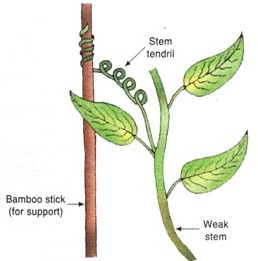- It enables animals and plants to adjust to their environment.
- Most animals move from place to place but some are sessile (i.e. fixed to the substratum).
- Majority of plants move only certain parts.
- However, though not easily observed all living protoplasm shows movement of one type or another.
Necessity for support and movement in plants
- They enable plants to be held upright to trap maximum light for photosynthesis and gaseous exchange.- To hold flowers and fruits in appropriate position for pollination and dispersal respectively.
- To enable plants to grow to great heights and withstand forces of environment e.g. strong winds.
- Movement of male gametes to effect fertilisation and ensure perpetuation of a species.
- Plant parts move in response to certain stimuli in the environment of tropisms.
Tissue distribution in Monocotyledonous and Dicotyledonous plants
- Vascular bundles are the main support tissues in plants.- In monocotyledonous stem they are scattered all over the stem while in dicotyledonous stem they are found in a ring or rings.
- In monocots the xylem and phloem alternate around with pith in the centre.
- In dicots of the xylem forms a star in the centre - there is no pith.
- Phloem is found in between the arms of xylem.
- Dicotyledonous plants have cambium which brings about secondary growth resulting in thickening of the stem and root hence providing support.
- Secondary xylem becomes wood, providing more support to the plant.


